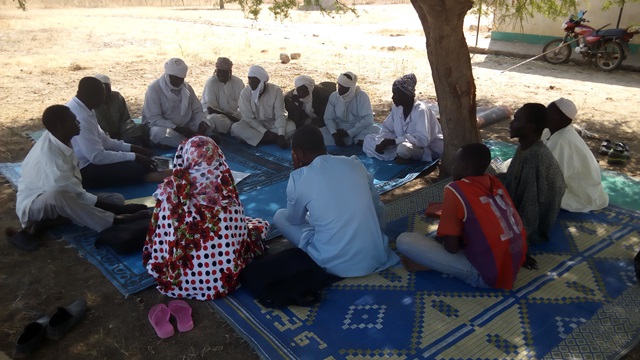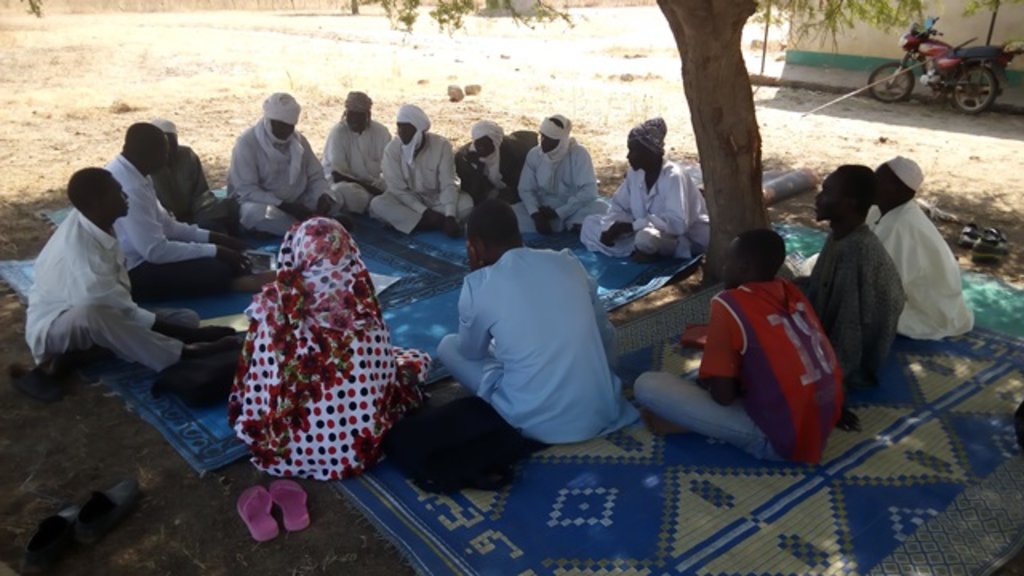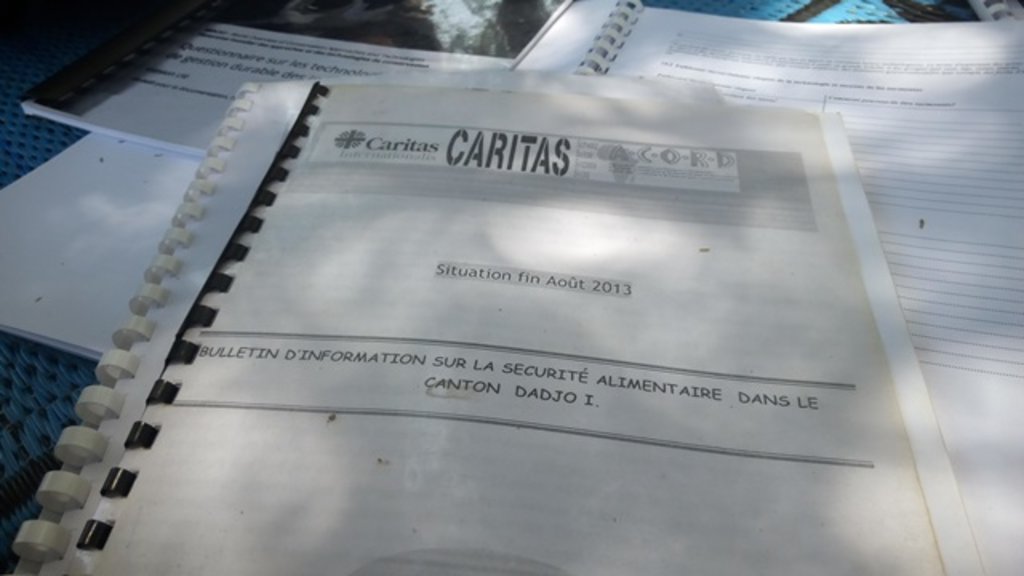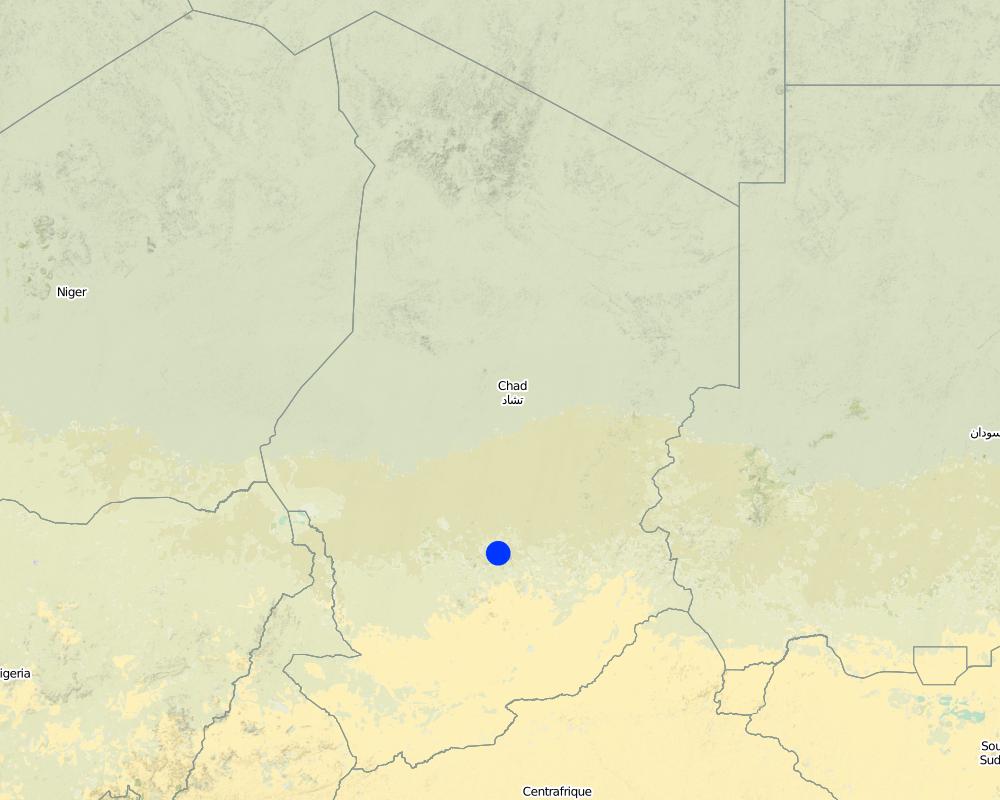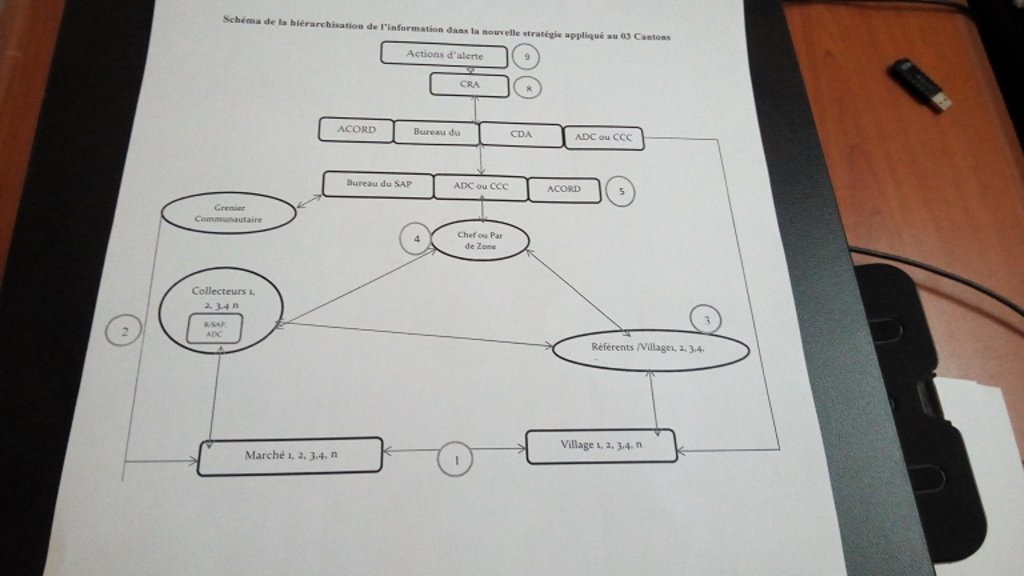Early Warning System [Chad]
- Creation:
- Update:
- Compiler: Mahamat Moussa Absakine
- Editors: Mahamat Moussa Absakine, Boris Orlowsky, Nicole Stolz, David Beritault
- Reviewers: David Beritault, Deborah Niggli
Khabar aldjallah aldjalah
approaches_1810 - Chad
View sections
Expand all Collapse all1. General information
1.2 Contact details of resource persons and institutions involved in the assessment and documentation of the Approach
Name of project which facilitated the documentation/ evaluation of the Approach (if relevant)
Book project: where people and their land are safer - A Compendium of Good Practices in Disaster Risk Reduction (DRR) (where people and their land are safer)Name of the institution(s) which facilitated the documentation/ evaluation of the Approach (if relevant)
CARITAS (Switzerland) - Switzerland1.3 Conditions regarding the use of data documented through WOCAT
When were the data compiled (in the field)?
29/10/2016
The compiler and key resource person(s) accept the conditions regarding the use of data documented through WOCAT:
Yes
2. Description of the SLM Approach
2.1 Short description of the Approach
The early warning system is a mechanism which enables to prevent risks related to food insecurity.
2.2 Detailed description of the Approach
Detailed description of the Approach:
The early warning system (EWS) is a mechanism which enables to prevent risks related to food security. This approach is applied by farmers in the district of Dadjo, in Chad. The Dadjo are an ethnic group from central Chad in the region of Guéra (department of Guéra). The EWS was implemented after a diagnosis which showed that the local actors were not sufficiently involved in the collection, processing and dissemination of data from the Local Action Committee (LAC) at the sub-prefectorial level, or from the Departmental Action Committee (DAC) at the departmental level. The information generated by these institutions was not regular and not reliable. Based on this diagnosis, it was decided to implement an endogenous mechanism which promotes the involvement of beneficiaries themselves in the collection, processing and dissemination of information.
The approach has the following objectives:
- Sharing real-time information on the risks of food insecurity;
- Promote a tool to combat food insecurity;
- Reinforce the resilience of local actors through rapid response.
The approach is based on a team of 12 collecting agents and 4 processing agents. The collecting agents collect the data among the households in the villages of the district of Dadjo. This team was formed by the NGO ACORD in the framework of its partnership with Caritas Switzerland. The data collection is done with forms designed with support from the NGO ACORD, taking into account local experiences and knowledge. The data collection is done periodically. For example from June to August, the collection is focused on the condition of the crops, pests and diseases, the market report or the price of food products on the local market, animal and human diseases, the condition of rangeland, etc. The data collected in this way are centralized at the level of the processing agents. The data are processed at this second level, and then the compiled data are sent to the Departmental Action Committee (DAC) for validation. Only after validation the information is disseminated to all the villages of the district during general village meetings. In addition, a three-monthly report with a synthesis of the information on the food security is generated. This report is presented to the persons in charge of the clusters of villages (4 clusters of villages were constituted, each cluster containing between 6 and 12 villages) for operation and wider dissemination.
The information of the EWS is used to plan the agricultural production activities. When the prospects for the agricultural season or the rainfall are bad, the inhabitants, which are informed about the situation, deploy alternatives like market gardening, the choice of an early variety for cereal production, stockpiling of cereals in the community storehouses, or the implementation of social mechanisms of mutual aid (provision of credit to the very poor).
The involved stakeholders are:
- the traditional and administrative authorities;
- the persons in charge of the civil society organisations.
Their role is to facilitate the implementation of the process that started in the district.
The farmers appreciate the rapid response provided by the communities, the investors and the state following the disseminated information, and the strong cohesion between the different communities. This has created ownership of the approach in the community, who then decided to motivate the collecting and processing agents. The Early Warning System of the Dadjo district has continued to function, at present without the support of the NGO ACORD.
2.3 Photos of the Approach
2.5 Country/ region/ locations where the Approach has been applied
Country:
Chad
Region/ State/ Province:
Guéra Region, Department of Guéra
Map
×2.6 Dates of initiation and termination of the Approach
Indicate year of initiation:
2013
If precise year is not known, indicate approximate date when the Approach was initiated:
less than 10 years ago (recently)
2.7 Type of Approach
- project/ programme based
2.8 Main aims/ objectives of the Approach
- Disseminate real-time information on risks related to food insecurity,
- Promote an instrument to combat food insecurity,
- Reinforce the resilience of local actors through rapid response.
2.9 Conditions enabling or hindering implementation of the Technology/ Technologies applied under the Approach
social/ cultural/ religious norms and values
- enabling
Social cohesion between the communities
availability/ access to financial resources and services
- hindering
The collecting agents committed themselves on a voluntary basis. However, they receive a small compensation for their work. These funds are retrieved from the community storehouses. One of the difficulties is that the community storehouses do not generate sufficient financial resources.
collaboration/ coordination of actors
- enabling
Joint action of the decentralized technical services of the state and the members of the early warning system to collect and analyse the data.
knowledge about SLM, access to technical support
- hindering
The team of processing agents needs continuous capacity building to be able to process and analyse the data.
3. Participation and roles of stakeholders involved
3.1 Stakeholders involved in the Approach and their roles
- community-based organizations
District Development Association (ADC)
- Awareness-raising and information activities in the villages
- Mobilizing financial contributions to facilitate the implementation
- local government
Decentralized technical services of the state
Data analysis
- international organization
ACORD - CHAD
CARITAS SWITZERLAND
- Coordination
- Financing
If several stakeholders were involved, indicate lead agency:
ACORD - CHAD and CARITAS SWITZERLAND
3.2 Involvement of local land users/ local communities in the different phases of the Approach
| Involvement of local land users/ local communities | Specify who was involved and describe activities | |
|---|---|---|
| initiation/ motivation | none | |
| planning | none | |
| implementation | interactive | Support from the technical services of the state, in particular from the Departmental Action Committee (DAC) of the department, and from ACORD, in the context of the processing and the analysis of the collected information. |
| monitoring/ evaluation | self-mobilization |
3.3 Flow chart (if available)
Description:
Organization chart of the early warning system (EWS):
(1) Locations of information collection
(2) and (3) Collecting agents and Village Officers (replacing the collecting agents in the villages)
(4) Verification of the information by the Chairpersons of the zones
(5) The Office of the EWS provides a global analysis of the information with support from ACORD
(6) Role of the State: without the authorization of the decentralized services from the State nor ACORD, nor the office of the EWS can issue the warning. The officials of the decentralized services of the State are involved in the approval of the information to be published. The unit charged with the verification in the department is the DAC (Departmental Action Committee).
(7) Promotion of community initiatives as endogenous responses. Only the community storehouse can provide an urgent response at the level of this zone.
(8) Extend the level of warning to a higher administrative level, which is the region.
(9) Make reference to all the warning actions to be taken at the national or international level in order to have a response in case of a crisis.
Author:
Moustapha Ali ( ACORD)
3.4 Decision-making on the selection of SLM Technology/ Technologies
Specify who decided on the selection of the Technology/ Technologies to be implemented:
- land users alone (self-initiative)
Specify on what basis decisions were made:
- personal experience and opinions (undocumented)
4. Technical support, capacity building, and knowledge management
4.1 Capacity building/ training
Was training provided to land users/ other stakeholders?
Yes
Specify who was trained:
- field staff/ advisers
Form of training:
- Training workshops
Subjects covered:
- Data collection techniques
- Techniques for data analysis and dissemination of information
- Techniques for monitoring and evaluation of the disseminated information
4.2 Advisory service
Do land users have access to an advisory service?
Yes
Specify whether advisory service is provided:
- at permanent centres
4.3 Institution strengthening (organizational development)
Have institutions been established or strengthened through the Approach?
- yes, greatly
Specify the level(s) at which institutions have been strengthened or established:
- local
- regional
Describe institution, roles and responsibilities, members, etc.
Members of the early warning system: 12 collecting agents and 4 processing agents.
Specify type of support:
- capacity building/ training
- equipment
Give further details:
Technical support to adopt the approach and to be able to replicate it.
Motorbikes for the collecting agents to facilitate their work, two computers, a printer and a rain gauge.
4.4 Monitoring and evaluation
Is monitoring and evaluation part of the Approach?
Yes
If yes, is this documentation intended to be used for monitoring and evaluation?
No
4.5 Research
Was research part of the Approach?
Yes
Specify topics:
- sociology
- economics / marketing
Give further details and indicate who did the research:
The approach EWS implemented in the district of Dadjo enables the collection of information on the prices of basic food products on the local markets of the district. The collection of this information makes it possible to inform farmers and livestock farmers on the prices, which allows them to sell their products at the appropriate time to guarantee substantial earnings.
5. Financing and external material support
5.1 Annual budget for the SLM component of the Approach
If precise annual budget is not known, indicate range:
- 2,000-10,000
Comments (e.g. main sources of funding/ major donors):
Mobilization of own contributions (per village)
External financing (Caritas Switzerland)
5.2 Financial/ material support provided to land users
Did land users receive financial/ material support for implementing the Technology/ Technologies?
Yes
If yes, specify type(s) of support, conditions, and provider(s):
The motorbikes were purchased by ACORD and financed by Caritas Switzerland. They were provided to the EWS of the district of Dadjo on a contract basis between the two parties. The district of Dadjo has committed itself to the maintenance of the motorbikes. After one year, the motorbikes were sold to the district to continue the activities of the EWS.
5.3 Subsidies for specific inputs (including labour)
- none
If labour by land users was a substantial input, was it:
- voluntary
5.4 Credit
Was credit provided under the Approach for SLM activities?
No
5.5 Other incentives or instruments
Were other incentives or instruments used to promote implementation of SLM Technologies?
Yes
If yes, specify:
The team which operates the EWS receives training on a regular basis. The team receives social recognition from the community for their work and voluntary engagement.
6. Impact analysis and concluding statements
6.1 Impacts of the Approach
Did the Approach empower local land users, improve stakeholder participation?
- No
- Yes, little
- Yes, moderately
- Yes, greatly
The inhabitants of the district, and especially the women, are increasingly involved and consulted in decision making on adaptations to climate change, from which the district of Dadjo suffers.
Did the Approach enable evidence-based decision-making?
- No
- Yes, little
- Yes, moderately
- Yes, greatly
For example the undertaking of market gardening activities when the disseminated information indicates that the current agricultural growing season is bad.
Did the Approach build/ strengthen institutions, collaboration between stakeholders?
- No
- Yes, little
- Yes, moderately
- Yes, greatly
The bonds of solidarity between the inhabitants of the district of Dadjo are strengthened, as well as with the other districts. The inhabitants understood the need to fully participate as actors in the development of their region.
Did the Approach improve gender equality and empower women and girls?
- No
- Yes, little
- Yes, moderately
- Yes, greatly
The women carry out income-generating activities to meet the needs of their households (health care, school fees, etc.)
6.2 Main motivation of land users to implement SLM
- increased production
Availability of seed during the agricultural growing season;
Increasing the area to be sown with cereals;
Spending sufficient time in own fields to have a better production.
- reduced risk of disasters
6.3 Sustainability of Approach activities
Can the land users sustain what has been implemented through the Approach (without external support)?
- yes
If yes, describe how:
After the end of the project that led to the implementation of the early warning system in 2013, the members of the early warning system continue their activities with persistence, by generating 06 news reports on the food security situation.
6.4 Strengths/ advantages of the Approach
| Strengths/ advantages/ opportunities in the land user’s view |
|---|
|
- Sharing of real-time information on the risks of food insecurity; - Rapid response provided after the dissemination of the information. |
| Strengths/ advantages/ opportunities in the compiler’s or other key resource person’s view |
|---|
|
- The strong relationship created with the traditional and administrative authorities; - Awareness on the effects of climate change. |
6.5 Weaknesses/ disadvantages of the Approach and ways of overcoming them
| Weaknesses/ disadvantages/ risks in the land user’s view | How can they be overcome? |
|---|---|
|
- Insufficient transport means (motorbikes) to cover all the villages of the district (46); - Weak community engagement to finance the Early Warning System and to motivate the collecting agents; - Insufficient financial means to produce sufficient reports. |
- Increase the number of available motorbikes; - Use of telephones; - Strengthen the awareness campaigns to raise funds. |
| Weaknesses/ disadvantages/ risks in the compiler’s or other key resource person’s view | How can they be overcome? |
|---|---|
| Low competence in data compilation, entry and analysis | Training |
7. References and links
7.1 Methods/ sources of information
- field visits, field surveys
25 persons
- interviews with land users
25 persons
Links and modules
Expand all Collapse allLinks
No links
Modules
No modules


